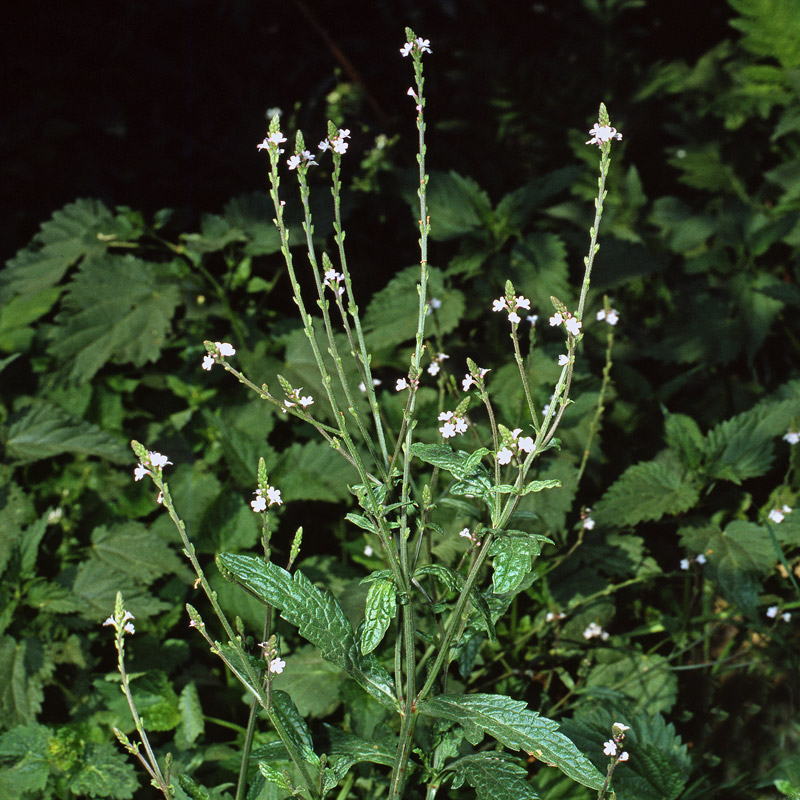Botanical name
Verbena officinalis L.
Family
Verbenaceae
Common name
Common vervain, Verveine
Information about the plant
Verbena is originally native to the Mediterranean region and is now found in temperate zones all over the world. In Europe, it grows from north to central Sweden, often in weed communities on roadsides, rubble pits, embankments, and walls.
The genus name Verbena comes from Latin and was generally used by the Romans for twigs worn during religious ceremonies. In the popular beliefs of the Romans and Gauls, the plant was thought to have magical powers and could protect against wounds from iron weapons. The German name ‘Eisenkraut’ (iron herb) also reflects this. The species epithet officinalis suggests that it is an old medicinal plant, as the ‘officina’ refers to the salesroom of a pharmacy, and ‘officinalis’ means commonly used in the pharmacy.
Verbena grows to a height of 20 to 60 cm, is often woody at the base, and branched in the inflorescence. The leaves are opposite on a square stem and are deeply incised to pinnate. The pale lilac-colored flowers are borne in spikes or panicles with a glandular, hairy spike axis. The corolla is indistinctly 2-lipped, with 2 shorter tips at the top and three longer ones at the bottom and stands in a 4- to 5-cleft calyx. It produces brown split fruits that easily split into four nutlets. It flowers from July to September.
Medicinally used parts of plants (herbal drug)
The dried herb, consisting of leaves, flowers, and stems (Verbenae herba), harvested at flowering time, is used.
The commercially available drug comes from wild collections in Southeast Europe.
Constituents of the herbal drug
Verbena contains iridoids, phenylethanoids, flavonoids, and essential oil (traces).
Quality of the drug
The quality of verbena (Verbenae herba) is specified in the European Pharmacopoeia (Ph. Eur.).
Medical applications
Recognised medical use
Verbena has not been evaluated by the HMPC or the ESCOP.
A combination preparation on the market contains verbena along with primrose flowers, gentian root, dock herb, and elderflower; this finished medicinal product is indicated for acute inflammation of the paranasal sinuses.
Traditional use
Verbena has not been classified as a traditional medicinal product (Article 16a of Directive 2001/83/EC).
Herbal drug preparations in finished dosage forms
- Cut verbena for tea preparations
- Powdered verbena in tablets
- Dry extracts in tablets
- Ethanolic-aqueous extracts in juices and drops
Dosage
Finished medicinal product: see patient information leaflet.
Tea: Drink a cup of verbena tea three times a day.
Preparation of a tea
Pour approximately 150 ml boiling water over 1.5 g verbena and strain after 10 minutes.
Notes
The efficacy and side effects of verbena used alone have not been sufficiently proven, which is why its use is not recommended. A combination with other drugs (see above) has proved effective and is recommended for adolescents aged 12 and above, as well as for adults. Use during pregnancy and lactation is not recommended due to a lack of evidence.
Side effects
Gastrointestinal complaints rarely occur (combination preparation).
Interactions
Not known.
References
Herbal drug monographs
Not known.
Further literature
Commentary on the German Pharmacopoeia (Verbena, No. 1854)


